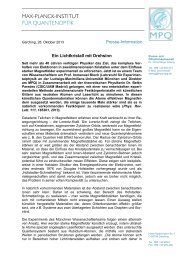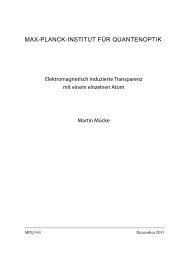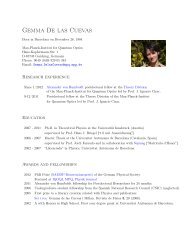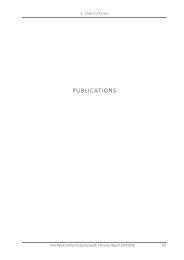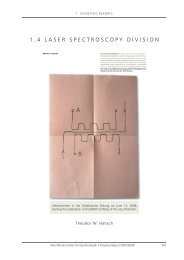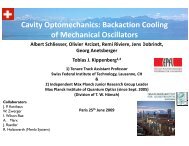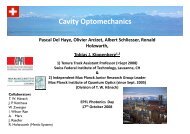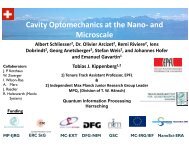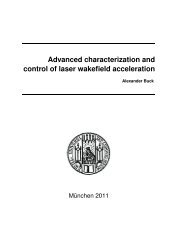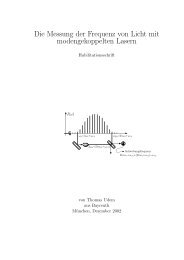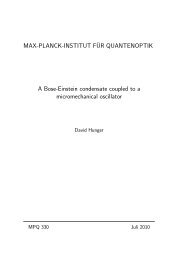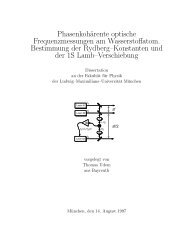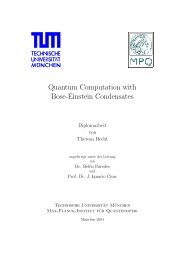Attosecond Control and Measurement: Lightwave Electronics
Attosecond Control and Measurement: Lightwave Electronics
Attosecond Control and Measurement: Lightwave Electronics
You also want an ePaper? Increase the reach of your titles
YUMPU automatically turns print PDFs into web optimized ePapers that Google loves.
1 . 3 AT T O S E C O N D A N D H I G H - F I E L D P H Y S I C S D I V I S I O N<br />
In another study, Vladislav Yakovlev has investigated the<br />
possibility of coherent superposition of laser-driven SXR<br />
harmonics in successive sources by one <strong>and</strong> the same<br />
laser pulse. His prediction of the feasibility of quasi-<br />
A<br />
B<br />
Figure 10: High-order harmonic generation from<br />
successive sources. (A) Schematic illustration of a<br />
sequence of harmonic sources formed by gas jets.<br />
The sources are arranged along the optical axis of<br />
a focused laser beam <strong>and</strong> pumped by one <strong>and</strong> the<br />
same laser pulse. In our first proof-of-concept study<br />
we have employed only two sources (depicted in<br />
black), further ones can be added for scaling the<br />
SXR harmonic yield in future experiments (depicted<br />
in grey). (B) Increasing the density of atomic dipole<br />
emitters tends to increase the coherent harmonic<br />
yield. However, increasing density causes the dipole<br />
oscillators to increasingly dephase along the laser<br />
propagation direction. In a single source, this leads to<br />
saturation of the harmonic yield at an atomic density<br />
corresponding to a backing pressure of ~ 40 mbar,<br />
red curve (calculated) <strong>and</strong> squares (measured).<br />
Splitting the generation medium into two equal<br />
sections <strong>and</strong> moving them apart so that the phase<br />
of the atomic dipole oscillations gets shifted by in<br />
the focused laser beam allows the atomic density to<br />
be increased by a factor of two (at backing pressure<br />
of ~ 80 mbar), leading to saturation at a factor of<br />
four higher harmonic intensities (blue curve <strong>and</strong><br />
diamonds).<br />
phase-matched SXR harmonic generation by a focused<br />
laser beam in a gas medium of modulated density<br />
has meanwhile been confirmed by our experimental<br />
observation of constructive <strong>and</strong> destructive interference<br />
between the harmonic signals originating from two<br />
successive sources, see Figure 10 [32]. Our proof-ofconcept<br />
study opens the prospect of enhancing the<br />
photon flux of SXR harmonic sources to levels enabling<br />
researchers to tackle a range of applications in physical<br />
as well as life sciences.<br />
Should attosecond pulse generation be scalable to<br />
photon energies of several kiloelectronvolts, attosecond<br />
X-ray diffraction might allow, one day, 4-dimensional<br />
microscopy with attosecond temporal <strong>and</strong> picometre<br />
spatial resolution. Drawing on the pioneering work of<br />
Ahmed Zewail, we also pursue this long-term goal by<br />
advancing ultrafast electron diffraction. To this end,<br />
Ernst Fill, Laszlo Veisz, <strong>and</strong> Sasha Apolonskiy have<br />
presented a novel concept of an electron gun for<br />
generating few-femtosecond- to sub-femtosecondduration<br />
electron bunches [33]. The basic idea is<br />
to utilize a DC acceleration stage combined with a<br />
microwave cavity, the time-dependent field of which<br />
generates an electron energy chirp for bunching at the<br />
target. To reduce space charge broadening, the number<br />
of electrons in the bunch is reduced <strong>and</strong> the gun is<br />
operated at a MHz repetition rate. In the absence of<br />
space charge (one electron per bunch), the duration<br />
of the generated electron wavepacket may potentially<br />
be shortened below 1 fs. The team around Ernst Fill,<br />
Martin Centurion <strong>and</strong> Peter Reckenthäler, have also<br />
devised a technique for measuring the bunch duration<br />
with potentially attosecond resolution [34] <strong>and</strong> have<br />
also performed preliminary time-resolved experiments<br />
with (multi-)electron bunches, which allowed them to<br />
image dynamics changes in the density distribution of a<br />
laser-induced plasma [35].<br />
1.3.1. 3 hIGh-FIElD ATTOSECOND SCIENCE: RElA-<br />
TIVISTIC ElECTRON CONTROl<br />
As described in Chapter 1.3.1.1, we pursue scaling of<br />
waveform-controlled few-cycle laser pulse generation to<br />
relativistic intensities in the expectation that controlling<br />
the motion of relativistic electrons with attosecond<br />
precision in time <strong>and</strong> nano- to micrometre precision in<br />
space paves the way towards scaling attosecond pulse<br />
generation to higher flux <strong>and</strong>/or photon energies <strong>and</strong><br />
may allow the development of compact, laboratory<br />
sources of brilliant X-rays. Simultaneously with our<br />
efforts aiming at laser development, in collaboration<br />
with Dieter Habs <strong>and</strong> his group, we are also conducting<br />
relevant proof-of-concept studies drawing on our<br />
laser sources currently available. Two routes are being<br />
pursued at MPQ: the development of a compact X-ray<br />
free electron laser seeded by laser-accelerated electron<br />
bunches <strong>and</strong> coherent harmonic XUV/X-ray pulse<br />
generated from relativistically-driven surfaces. In this<br />
142 Max-Planck-Institut für Quantenoptik • Progress Report 2007/2008



